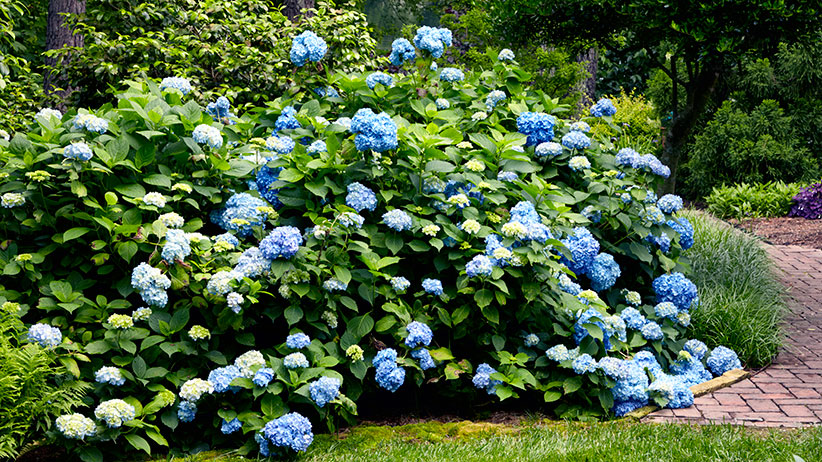Why you should add bigleaf hydrangeas to your garden
Bigleaf hydrangeas are not only beautiful but among the easiest flowering shrubs you can plant. Learn how to care for your bigleaf hydrangeas the right way here.
How to grow bigleaf hydrangeas
Ideal conditions for the most flowers and healthiest foliage include a moist, humusy, well-drained soil in full sun to part shade. In areas with very hot summers (USDA zones 7 and warmer), a little afternoon shade will keep the foliage from scorching. Apply a couple doses of a balanced, 10-10-10 fertilizer (one in spring and again after flowering) for the most and best flowers.
Provide hydrangeas consistent moisture
Hydrangeas like consistent moisture and often have drooping leaves when they get overly dry. An inch or two of water each week, along with a 2- to 3-inch layer of organic mulch will keep the plants healthy. At times when temps soar into the upper 80s and above, foliage will flag even with ample moisture. If the soil feels moist, leave the plant alone. Once things cool later in the day, the leaves recover quickly.
You Might Also Like:
Seven bigleaf hydrangea cultivars for your garden
4-Season hydrangea garden border plan
Long-lived perennials for your garden
Statement plants

How to change the flower color of your hydrangea
Another neat feature of these plants? You can change the color of the flowers. Except for white-flowered ones and a few others, most can range from bright pink to true blue depending on your soil’s pH and the presence of aluminum.
For your hydrangeas to be blue, aluminum (which is present in most soils) must be available to the plant. In acid to neutral soils this isn't a problem. But in alkaline soils, the roots can't take up the aluminum and the flowers will be pink.

Do a soil test to determine your soil pH
Do a soil test to find out what you have. If your soil is acid to neutral, and your flowers are pink but you’d like blue, apply some granular aluminum sulfate, sulfur or iron sulfate to acidify the soil. Ask at your local garden center what works best in your area.
Always follow package directions carefully, as too much can stunt or kill your plant. Give this several months to work. Two or three lighter applications are better than one heavy one. Once you’ve lowered the pH, feed the plant Miracid® to help maintain the soil acidity. Try grouping plants together so you only have to change the pH in one area.

Adjusting akaline soil
If your soil is alkaline, you can try to acidify it by working in lots of organic material and adding elemental sulfur gradually over several years. But if your pH is 7 or higher, this probably won’t work. Of course, you can always grow blue-flowered ones in containers. With just that small amount of soil, you can more easily control the pH.
Pruning bigleaf hydrangeas
Except for the Endless Summer series, most bigleaf hydrangeas bloom on mature wood. That means the plant actually forms the buds for the following year’s flowers in late summer to early fall. You don’t want to cut off the flower buds and miss out on the beautiful blooms! So a little light trimming in early spring is generally all that’s required: Just cut back any old flower heads to the closest leaf nodes.
In especially bitter winters, the tips of the stems may be killed by the cold. Go ahead and remove what’s died back. Although you’ll have lost the flower buds at the tips of the stems, this pruning sometimes stimulates the dormant side buds to develop and bloom. Should the entire plant die back in a severe winter, cut it down to the ground in early spring. The roots of an established plant will usually survive and send up new growth as the weather warms.
You Might Also Like:
How to take softwood cuttings from your hydrangea
Side yard makeover
Panicle hydrangeas for your garden
Easy spring container ideas
Choosing the right bigleaf hydrangea for your garden
If you garden where temperatures tend to fluctuate wildly in spring, the emerging flower buds may be killed by cold snaps in late spring. For most bigleafs hydrangeas, this results in no blooms for the season. Planting in a northern or eastern exposure makes them less likely to break dormancy too early in the season and be nipped by a late frost.
You might also try growing more cold-hardy cultivars, such as ‘Nikko Blue’ or ‘Blue Billow’. And newer cultivars that bloom on both old and new wood, such as Endless Summer, are other good choices. Even if the flower buds are winter-killed on these plants, more buds will form on the new growth and you’ll still enjoy the midsummer flowers.
Beware: Deer like hydrangeas too
Deer tend to like bigleaf hydrangeas, so if they’re a problem in your area, use a spray repellent regularly, especially during the growing season, to keep these hungry critters from making your garden their buffet line.
















